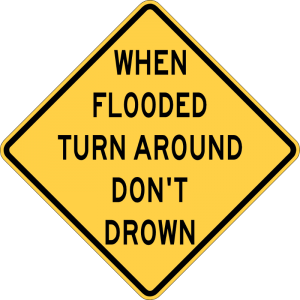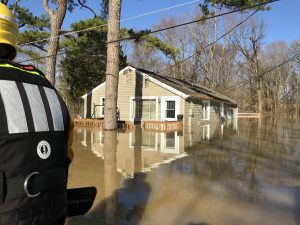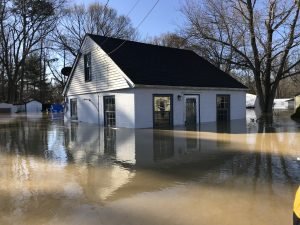Flood Safety
Flooding is a temporary overflow of water onto land that is normally dry. Floods are the most common natural disaster in the United States. Failing to evacuate flooded areas or entering flood waters can lead to injury or death.
Floods may:
- Result from rain, snow, coastal storms, storm surges and overflows of dams and other water systems.
- Develop slowly or quickly. Flash floods can come with no warning.
- Cause outages, disrupt transportation, damage buildings and create landslides.
IF YOU ARE UNDER A FLOOD WARNING, FIND SAFE SHELTER RIGHT AWAY

- Do not walk, swim or drive through flood waters. Turn Around, Don’t Drown!
- Just six inches of moving water can knock you down, and one foot of moving water can sweep your vehicle away.
- Stay off of bridges over fast-moving water.
- Evacuate if told to do so.
HOW TO STAY SAFE WHEN A FLOOD THREATENS
Prepare NOW
- Know types of flood risk in your area. If you live near the Ohio river or a creek that is directly affected by river flooding, know where to find the River Forecast information from NOAA. If you are not sure of you live in a Flood Hazard Area contact the Clarksville Floodplain Administrator at: (812) 283-8233 Ext. 101 to receive assistance in determining the status of your property. Or visit the Indiana Department of Natural Resource’s Floodplain Portal and enter your address.
- The Town of Clarksville employs the Everbridge Emergency Alert System. This system is capable of sending a text messages, emails, and automated phone calls to the entire community or selected areas as may be impacted by natural or manmade hazards. There is no charge for this service however you must Sign-up to participate. It is also suggested that you keep a battery-operated weather radio handy and in working condition in order to receive weather and other emergency updates.
- If flash flooding is a risk in your location monitor potential signs, such as heavy rain forecast along with current conditions such as saturated ground and already standing water.
- Learn and practice evacuation routes, shelter plans and flash flood response.
- Build an Emergency Supply Kit in case you have to leave immediately or if services are cut off.
- Purchase or renew a flood insurance policy. Homeowner’s and or renter’s policies do not cover flooding. It typically takes up to 30 days for a policy to go into effect so the time to buy is well before a disaster. Get flood coverage under the National Flood Insurance Program (NFIP).
- Keep important documents in a waterproof container. Create password-protected digital copies.
- Protect your property. Move valuables to higher levels. Declutter drains and gutters. Install check valves. Consider a sump pump with a battery.
- Take photos and videos of all major household items and valuables. Retain these documents in a safe place because they are important when filing insurance claims.
 Survive DURING
Survive DURING
- Go to the safe location you previously identified.
- If told to evacuate, do so immediately. Never drive around barricades. Local responders use them to safely direct traffic out of flooded areas.
- Listen to the NOAA Weather Radio or local alerting systems for current emergency information and instructions.
- Do not walk, swim or drive through flood waters. Turn Around. Don’t Drown!
- Stay off bridges over fast-moving water. Fast-moving water can wash bridges away without warning.
- If your car is trapped in rapidly moving water stay inside. If water is rising inside the car get on the roof.
- If trapped in a building go to its highest level. Do not climb into a closed attic. You may become trapped by rising floodwater. Only get on the roof if necessary and once there signal for help.
Be Safe AFTER
- Listen to authorities for information and instructions. Return home only when authorities say it is safe. Prior to re-entering the home, it must be inspected for structural damage by a representative of the Clarksville Building Commissioners Office. They can be contacted at (812) 283-1510.
- If the building is deemed safe by the Building Commissioner, the owner may then enter and begin clean-up activities only. No repairs can be performed until after the necessary permits are in place and the home has been inspected by the Floodplain Administrator.
- Watch for Snakes and other animals which may be in your house. Wear heavy gloves and protective footwear during clean up.
- Be aware of the risk of electrocution. Do not touch electrical equipment if it is wet or if you are standing in water. If it is safe to do so, turn off the electricity to prevent electric shock.
- Avoid wading in floodwater, which can be contaminated and contain dangerous debris. Underground or downed power lines can also electrically charge the water.
- Use a generator or other gasoline-powered machinery ONLY outdoors and away from windows.
Links to other flood related information:
https://www.fema.gov/national-flood-insurance-program
https://www.fema.gov/es/programa-nacional-de-seguro-por-inundaciones
https://www.weather.gov/safety/flood-turn-around-dont-drown
https://www.moneygeek.com/insurance/homeowners/protecting-your-home-against-floods/
https://www.moneygeek.com/insurance/hazard-fire-flood-earthquake/
Other Floodplain and System Information

Mandatory Purchase Requirement: The Flood Disaster Protection Act of 1973 and the National Flood Insurance Reform Act of 1994 made the purchase of flood insurance mandatory for federally backed mortgages on buildings located in Special Flood Hazard Areas (SFHAs). It also affects all forms of Federal or Federally related financial assistance for buildings located in SFHAs. The SFHA is the base (100-year or 1%) floodplain mapped on a Flood Insurance Rate Map (FIRM). It is shown as one or more zones that being with the letter “A” or “V.”
The rule applies to secured mortgage loans from such financial institutions as commercial lenders, savings and loan associations, savings banks, and credit unions that are regulated, supervised, or insured by Federal agencies such as the Federal Deposit Insurance Corporation (FDIC) and the Office of Thrift Supervision. It also applies to all mortgage loans purchased by Fannie Mae or Freddie Mac in the secondary mortgage market.
Federal financial assistance programs affected by the laws include loans and grants from agencies such as the Department of Veterans Affairs, Farmers Home Administration, Federal Housing Administration, Small Business Administration, and the Department of Homeland Security’s Federal Emergency Management Agency (FEMA).
How it works: Lenders are required to complete a Standard Flood Hazard Determination (SFHD) form whenever they make, increase, extend or renew a mortgage, home equity, home improvement, commercial, or farm credit loan to determine if the building or manufactured (mobile) home is in a SFHA. It is the Federal agency’s or the lender’s responsibility to check the current Flood Insurance Rate Map (FIRM) to determine if the building is in a SFHA. Copies of the FIRM are available for review in the Clarksville Building Commissioner’s office at the Town Hall, at 2000 Broadway, second floor. Lenders may also have copies or they use a flood zone determination company to provide the SFHD form.
If the building is in a SFHA, the Federal agency or lender is required by law to require the recipient to purchase a flood insurance policy on the building. Federal regulations require building coverage equal to the amount of the loan (excluding appraised value of the land) or the maximum amount of insurance available from the NFIP, whichever is less. The maximum amount available for a single-family residence is $250,000. Government sponsored enterprises, such as Freddie Mac and Fannie Mae, have stricter requirements.
The mandatory purchase requirement does not affect loans or financial assistance for items that are not covered by a flood insurance policy, such as vehicles, business expenses, landscaping, and vacant lots. It does not affect loans for buildings that are not in a SFHA, even though a portion of the lot may be. While not mandated by law, a lender may require a flood insurance policy, as a condition of a loan, for a property in any zone on a FIRM.
If a person feels that a SFHD form incorrectly places the property in the SFHA, he or she may request a Letter of Determination Review from FEMA. This must be submitted within 45 days of the determination. More information can be found at FEMA.gov
FLOODPLAIN PERMIT REQUIREMENTS
All development within the 100-yr. floodplain (not just construction of buildings, but filling, excavation, fences, etc.) may be required to obtain a Town of Clarksville permit Applications must be made prior to doing any work in a floodplain area. Please contact the Floodplain Administrator to receive all the information you will need in order to properly develop in the floodplain at (812)283-8233 Ext 201. You may report any illegal development activities to the above number as well.
SUBSTANTIAL IMPROVEMENT/DAMAGE
The NFIP requires that if the cost of improvements to a building or the cost to repair damages (from any cause) to a building exceeds 50% of the market value of the building (excluding land value), the entire building must be brought up to current floodplain management standards. Building improvement projects include exterior and interior remodeling, rehabilitation, additions and repair and reconstruction projects. To avoid costly mistakes, always contact the Clarksville Building Commissioners Office prior to initiating any improvements. There are horror stories out there from some residents that neglected to do so.
NATURAL & BENEFICIAL FUNCTIONS
Floodplains play a valuable role in providing natural and beneficial functions to the area around, and including, Clarksville and must be protected. Floodplains that are relatively undisturbed provide a wide range of benefits to both human and natural systems. These benefits provide aesthetic pleasure as well as function to provide active processes such as filtering nutrients and pollutants from urban stormwater runoff. Floodplains also provide natural erosion control and open space so further flooding damage does not occur.
DRAINAGE SYSTEM MAINTENANCE
As simple as it may sound, simply keeping smaller ditches and streams free of debris can dramatically improve the run-off capacity of low-lying areas, as well as greatly reduce the occurrence blockage that significantly contributes to flooding. It is illegal to dump materials into the Town’s storm sewer system and waterways and violators may be fined If you see someone in the act of dumping or see debris in one of our watercourses, please contact the Public Works office at (812) 283-8233.
Click Here to Review the Floodplain Determination
Click Here to View the Clark County Multi-hazard Mitigation Plan
510 Progress Report 2022
510 Progress Report Exhibit A 2022